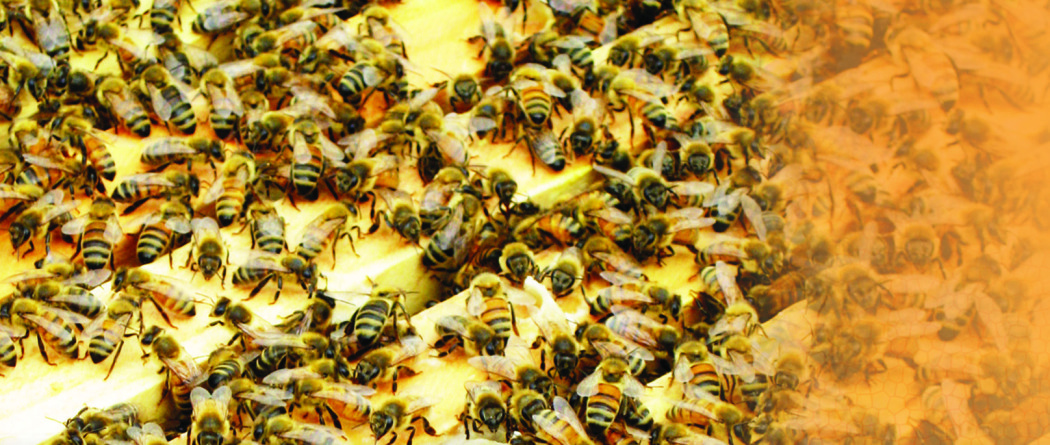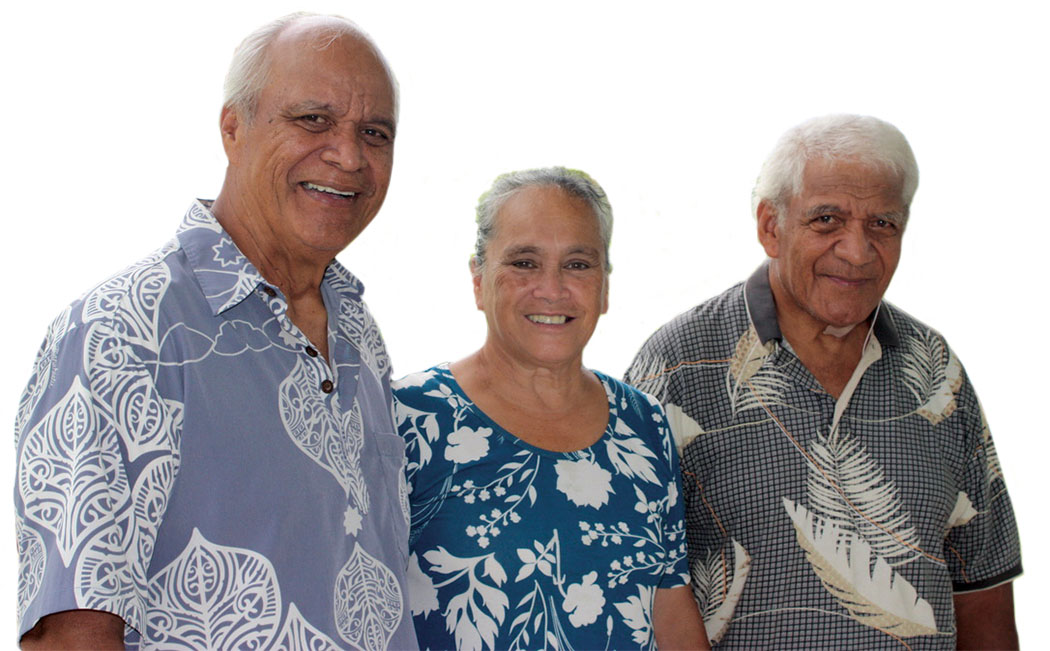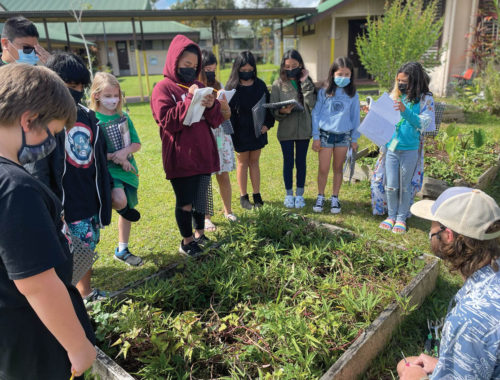
The Plight of the Honeybee: Big Island Honeybees are Vital to Keeping Us Fed, Our Skin Soft and Even Healing Cuts on Fish Fins

By Denise Laitinen
Raw honey may look like liquid gold, but it is the bees themselves that are worth their weight in gold.
“Albert Einstein once said that without honeybees the human race as we know would end in seven years,” says Dr. Lorna Tsutsumi, Entomology Professor at the University of Hawai‘i at Hilo and head of the school’s beekeeping program.
Bees are key when it comes to pollination and plant reproduction. “If we look at the importance of honeybees in terms of [crop] sustainability, it’s crucial,” adds Lorna. Bees are in the business of gathering nectar and pollinating flowers. It’s also how they make honey.
“Bees are responsible for 90 percent of the world’s food supply,” says award-winning Honolulu Chef Alan Wong. “And they’re in danger of disappearing.”
For centuries, Hawai‘i’s geographical remoteness meant that bees were relatively free of pests. In recent years however, Hawai‘i Island honeybees have been hit by the double whammy of varroa mites and small hive beetles.
Varroa mites were first found on Hawai‘i Island at beehives in the Hilo area in August 2008. The tiny insect attaches itself to the bee’s abdomen and “sucks the life force out of the bee,” explains Ron Hanson, owner of Best Big Island Bees in Pahoa, who has several decades of experience with bees. The mite also prevents the bee from growing to a mature size. The effect of the mite on the island bee population was profound for both feral honeybees and managed hives.
“It almost devastated it,” says Hanson, of the island’s bee population. “Some people claim there were 800,000 feral bees on island before the mite got here,” he adds. Anecdotally, it’s believed that the varroa mite has wiped out 50 percent of the island’s bee population.
As if that weren’t bad enough, the small hive beetle arrived shortly thereafter in 2010. “Small hive beetles devastate hives by entering a hive and emitting a pheromone that causes the queen bee to shut down her egg-laying process; it eventually turns the honeycomb to slime,” explains Hanson. “Beetles come in when hives are weak—maybe because of mites,” he adds. Beetles can cause a honeybee hive to crash in a matter of days.
The honeybees’ plight is not a lost cause yet. Everyone from lawmakers to chefs to educators and the beekeepers themselves have rallied around saving the honeybees.
For Chef Wong and Dr. Tsutsumi, helping bees is a crucial part of ensuring our food supply for the future.
“So many crops rely on bees, we need them to help keep our island independent and sustainable,” says Tsutsumi.
“Our company’s definition of sustainability is that our children’s children have a future tomorrow,” explains Chef Wong. “They [bees] pollinate fruits and vegetables. That’s why chefs are concerned about bees.”
To help build awareness about honeybees and their importance, Chef Wong and Dr. Tsutsumi created the “Adopt-A-Beehive with Alan Wong” program at University of Hawai‘i-Hilo. [See sidebar.] The program encourages public involvement in the future of honeybees and sustainable agriculture, as well as raising funds for the only college bee-keeping program in the state. In March, 2012, Tsutsumi, Wong, and UH-Hilo Chancellor Donald Straney were recognized by the Hawai‘i State Legislature for their efforts to save honeybees on the Big Island.
Even lawmakers have gotten involved in efforts to save honeybees. “Bees mean sustainability,” says State Representative Clift Tsuji, who chairs the committee on agriculture.
Earlier this year Tsuji introduced House Bill 2100, which proposes appropriating $50,000 to the University of Hawai‘i for bee hive research statewide. Supported by the Hawai‘i Farm Bureau Federation and the Big Island Beekeepers Association, the measure had passed the House and was under consideration by the Senate as this magazine went to print.
While beekeepers have been trying a variety of approaches for dealing with the invasive pests—using everything from chemicals and powders to natural, non-commercial approaches—beekeeping organizations have stepped up education efforts.
Last year the Western Apicultural Society held its annual conference on Hawai‘i Island in Kohala in conjunction with the Big Island Beekeepers Association Second Annual Hawaiian Natural Honey Challenge. The event brought together experts and beekeepers to learn about solutions for dealing with the pests.
For Hanson, who won the Best-in-Show Award in the liquid category for his Christmas berry honey and Best Taste in the solid honey category for his mango honey at last year’s Honey Challenge, learning how to combat the pests is one of the best ways to move forward.
“The most important thing I see is to rebuild and educate,” says Ron, noting that he doesn’t use chemicals on his hives, preferring instead to use natural methods.
“When I lose hives, I want to learn why so I can learn from it,” says Ron. “When I first started losing bees to the beetle, it was pretty bad,” he adds. “It’s almost like seeing your dog get hit by a car.”
“It was overwhelming,” adds his son, John Hanson, who is also involved in the family’s beekeeping business. An avid beekeeper himself, John won the People’s Choice Award and Best Texture in the solid honey category at the Second Annual Hawaiian Natural Honey Challenge.
Hanson offers monthly education training classes for beginner and advanced beekeepers.
“People have a perception that it’s really difficult to maintain bees,” says Ron. “I find that it’s easier to keep a few beehives than it is to feed your dog and cat. Even some experienced beekeepers have a perception that it’s difficult to keep hives because their hives died in the past. It gets back to education.”
Both father and son point to the need to increase awareness among local farmers about the importance of bees in terms of pollination. “If more people had hives, we wouldn’t have nearly as much of a problem with pollination,” adds John.
Ron recounts a situation in which a macadamia nut grower on island complained about his low-yielding crop. “But he had no bees in his area,” explains Ron. “His neighbor had bees and saw a 30 percent increase in their macadamia nut crop when they incorporated the bees.”
Beekeeping isn’t just for agricultural purposes; it also creates an array of value-added products. Honey is, of course, the best-known item made by honeybees, but they also make many other useful items. Propolis is a sticky resin mixture that honeybees collect and use to fill open spaces in a hive, reinforcing the hive’s structural stability. Widely appreciated by natural medicine practitioners for its health benefits, propolis is thought to have antibiotic and antifungal properties. It’s also associated with promoting heart health, as well as treating inflammations, ulcers and burns.
“There are quite a few people that buy it,” says Ron. “They use it for tinctures or balms.”
“We’ve had fish farmers buy it for use on their koi fish,” adds John. “A fellow who bought it said he makes a solution with the propolis and sprays it on the koi’s fins to help heal cuts.”
Beeswax is another important value-added honeybee product. John points out that beeswax can be used in everything from candle making to woodworking. Candle making is probably the most obvious use of beeswax, but it is also very popular with woodworkers who use it on hand-crafted furniture and surfers who use it on their surfboards.
Ron notes that, by and large, their biggest buyers of beeswax are local cosmetic companies. Indeed, nationally, the cosmetics industry is the largest consumer of beeswax in the country. It’s used in everything from facial creams and lotions to lip balms and lipsticks. Beeswax is a popular ingredient in hand and body creams, because it contains wax esthers that helps to increase moisture in the skin.
Local beekeepers that sell beeswax help the island economy by offering a local, natural product used by other local companies. It saves the cosmetics companies from importing beeswax and keeps money invested in the local economy.
Of all the products that are made by bees, Ron Hanson believes the most important item is the bees themselves.
“Very few people sell bees on island. People can buy bees to start their own hives or their own apiary,” explains Ron.
“We’ve got nice habitat for bees. We’ve got excellent resources for pollination and year-round flower sources,” says Ron.
“If you take care of the bees the hives will grow.”
As the honeybees flourish, so does local agriculture and local commerce. ❖
Contact writer Denise Laitinen: wahineokekai@yahoo.com
To learn more about bees and beekeeping:
Big Island Beekeepers Association: bibahawaiibees.org
Statewide: hawaiibeekeepers.org
Bee education opportunities:
Best Big Island Bees, Pahoa. Ron Hanson, 808.965.0000, bbibees@hotmail.com. Offers three-part series on beginning beekeeping; classes on first three Saturdays of the month.
Bee Love Apiary, Hāmākua Coast, Jenny Bach, 808.640.0278, beelovehawaii.com. Next class offered: Introduction to Organic Beekeeping, June 9-July 7 (five-week class held on Saturdays). Offered in partnership with Volcano Island Honey Company. Also offers free outreach presentations and apiary field trips to Hawai‘i Island schools.
Volcano Island Honey Company, Honoka‘a, Richard Spiegel, 808.775.1000, volcanoislandhoney.com. Offers farm and beehive tours, as well as educational tours for Hawai‘i Island schools.
Big Island Bees, Kealakakua, Garnett and Whendi Grad, 808.324.0295, bigislandbees.com. Big Island Bees is developing an educational program about how honey is made and the nature of beekeeping. As we go to press they expect the program to be starting in June 2012. Call for more info.
UH-Hilo: the University’s College of Agriculture, Forestry, and Natural Resource Management offers courses in beekeeping for students interested in pursuing careers in the apiary field. Dr. Lorna Tsutsumi, 808.974.7719, tsutsumi@hawaii.edu
UH CCECS: Noncredit classes on beekeeping are offered by the UH College of Continuing Education and Community Service. ccecs@hawaii.edu, 808.974.7664. Taught by Danielle Downey, an apiculture specialist with the Hawai‘i Department of Agriculture.


